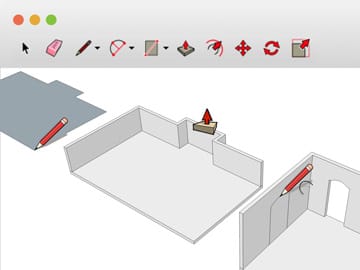
- #Sketchup online tutorial install
- #Sketchup online tutorial series
- #Sketchup online tutorial download
- #Sketchup online tutorial free
- #Sketchup online tutorial windows
Double click on a material and anything that is covered with that in the scene is selected. This lists firstly all the different materials used in the model, then the lights (in this case just the sun), then the cameras (views) that we already set up. The most important part to look at is the long list down the left hand side. Under the main menu are some quick links – the first set do the usual open/close stuff, the next block are the tools for navigating around your model (which we’ll ignore as our scenes are already set up), then there’s some links to certain views (which we’ll again ignore) and finally some render buttons, which obviously we’ll be using later. Let’s look at the user interface briefly. A photo applied in the background is a nice touch that I find helps add to the realism.
#Sketchup online tutorial windows
Since I want the glass of the table and the glass in the windows to render differently, I’ve given them different sketchup textures (which I’ll then play around with inside Kerkythea). So here’s a model I made earlier, with some extra furniture from the web – I’ve already got a floorboards texture I like, so have applied that all over the floor in SketchUp. Kerkythea works by separating parts of your model by material, so anything you want rendering differently needs to have a different material applied to it. The components in these packs are pre-drawn SketchUp models of useful objects like furniture, cars and trees.Īny materials you apply in SketchUp, the sun and shadows, and any scenes are all exported into Kerkythea, and in many ways it’s easier to set all this up in SketchUp. Some fine detail is always good – I like to add in some funky furniture from the Google SketchUp online component library found at the 3D Warehouse. So, first create your model – time spent here is definately worth it, your render will never look good without a good model behind it. The only buttons you’ll really need are the first, 4th and 5th buttons from the left – number 1 exports the model, and the other two are light components (which I’ll cover in another tutorial, we’ll stick to daylight for now). You’ll also need the exporter so you can export your models from SketchUp to Kerkythea, available at the Kerkythea Forum.Īssuming you’ve installed the Sketchup exporter, you’ll see this exciting new toolbar.
#Sketchup online tutorial install
To install these into Kerkythea, go to file -> install library and select the zip file you downloaded. The more you have now, the quicker you can churn out renders later – try the Kerkythea resources to get you started, you can search here.
#Sketchup online tutorial download
I’ll assume you can manage that without a tutorial…Īlso, download and install as many materials etc. as you can, again from the Kerkythea website.

Obviously first you need to download and install the latest version of Kerkythea from their website here. This tutorial takes you through the basics (assuming that you can already use SketchUp to some degree), which should be enough for you to try out a few things of your own.
#Sketchup online tutorial free
enter Kerkythea, a completely free to download yet suprisingly sophisticated rendering program, which can also conveniantly produce renders with minimal work involved. So you’ve made that SketchUp model, and want to turn it into a funky architectural render with minimal effort and without shelling out any money on flash software…. Theoretically works on multiple paths at once.Architectural Rendering with SketchUp and Kerkythea
#Sketchup online tutorial series
Extrude Edges by Loft is very similar to the face creation by curviloft – you can select a series of lines, then generate a face with them.You can use a 4th profile (a “Melding Profile”) to direct the final direction of the extrusion

Extrude Edges by Rails – This allows you to take an edge and use other edges, or rails, to extrude it.Extrude Tools for SketchUp Extension Functions


 0 kommentar(er)
0 kommentar(er)
